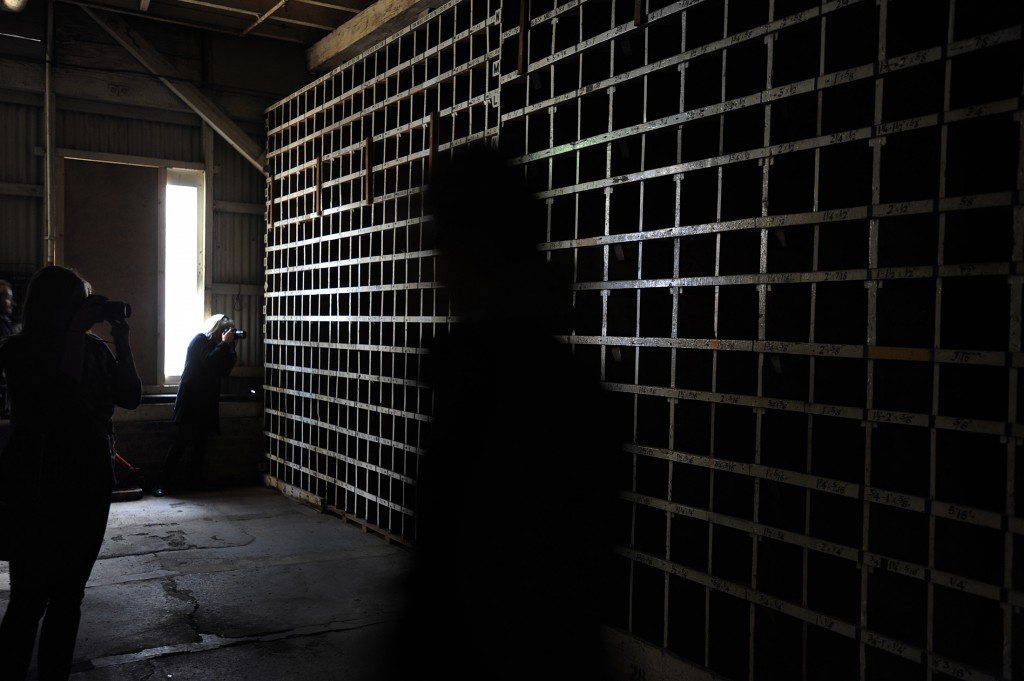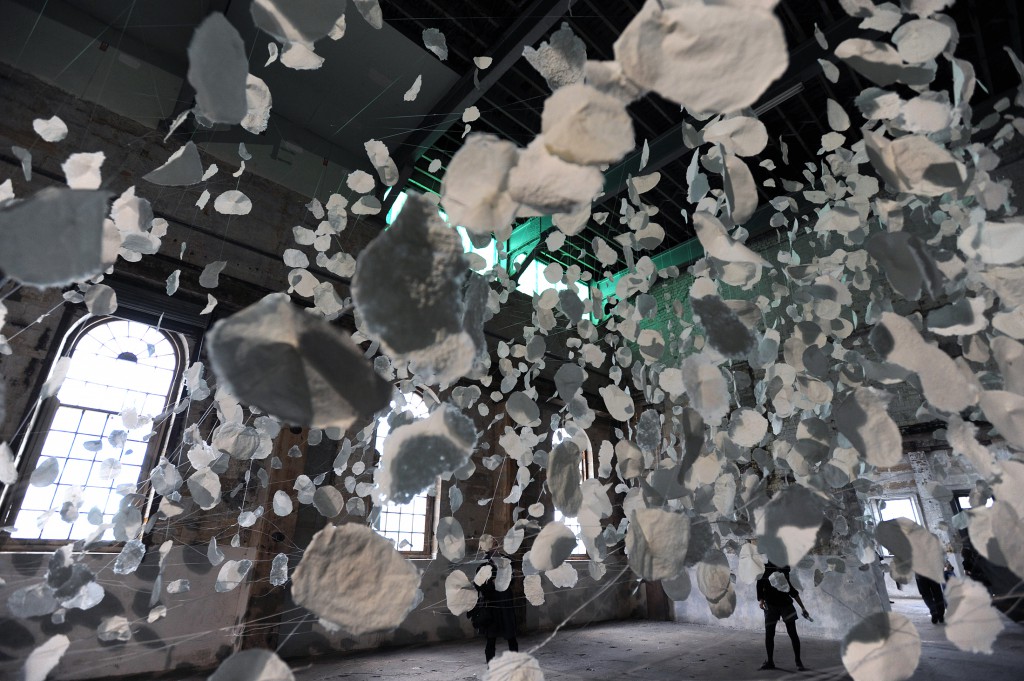
An older style Sydney ferry, the Borrowdale approaches Cockatoo Island having set out from Sydney’s main terminal at Circular Quay.

The main gateway building to Cockatoo Island saw a record 157,000 visitors pass through to see and experience the 2012 the 18th Biennale of Sydney.

Overshadowed by gantries and long disused cranes, visitors to the Biennale loose themselves in the relative coolness of the dry mist used in the Japanese artist Fujiko Nakaya’s exhibit entitled Living Chasm.

In the shipyards General Store, pigeon hole style shelving, still carries markings denoting the specific items once carried.

This massive laser cut styrofoam sculpture (20 times large than what is shown here), the largest exhibit at the Biennale, was created by New Zealand artist, Peter Robinson. Its representation of the islands sandstone base being shaped by convicts, and the huge links of chain signifying the shipyard itself.

Challenging to some, Colombian artist Maria Fernanda Cardosa exhibit in the ‘Museum of Copulatoty Organs’ proved fascinating to those that made it through the entrance. The exhibit showed highly finished larger than life plaster casts of many of the insect worlds sex organs.

The church style windows, some with aqua coloured glass, cast mixed light on Australian artist Monica Grzymala’s cotton rag paper and twig representaion of the cycle of life.

Inside the entrance of the Front Machine Shop, this constantly moving projection of ‘cats cradles’, engaged children whith its interactivity.

Based on the belief that all matter in the universe has a life of its own, English born Philip Beesley, created an amazing work, a hybrid that combined engineering, experimental chemistry, sculpture and architecture that in several ways, physically responded to the human presence.

The geometry of these neon tubes seemed to contrast greatly with this convict dug tunnel excavated around the mid 1800’s. There are two such tunnels which provide acess from one side of the island to the other.

A group of Japanese tourists realax after spending an afternoon on the island. In the background, the Sydney Harbour Bridge, and rising above the CBD at 300 metres in height, Centrepoint tower.

Ria Verhaeghe ehibited her work in the chapel of the old Prison Complex. Hailing from Bruges in Belgium, she combined newspaper, hair, cloth and latex to reveal the world that hides and fluctuates within images we see in the press everyday and how we correlate these in our everyday reality.

The Scar Project 2005-2012 by Montreal’s Nadia Myre, contained a great number of small works on canvas, requiring three roons to show them with great effect. Essentially, each canvass portrayed a scar in a persons life, sewn by the individual themselves, representing the physical, spiritual, psychological or emotional aspects of those scars.

This work, a reflection on the artist hersef, and her regret of the passing of her youthfull innocence and the transition into the ‘harsh’ and sometimes ‘cruel’ place that is the world of her adulthood. Jin Nu from China, opposes the collectivised thinking at the time of her growing up under the One Child Policy.

The industrial background of the Main Turbine Hall was being used as the ‘set’ or backdrop for this bride and grooms wedding photographs.

A ‘peek’ into one of the many big spaces that are a feature of the many wonderful locations used to exhibit the ‘artists works’. New Zealand born artist Sriwhana Spong works across different mediums of assemblage, video and performance. References to the body, mythology and dance combine with modernist abstraction are used in this work exhibited in what was once the Electrical Shop.

Open to the sun and wind, this work by Chilean artist Cecilia Vicuna represents the ancient form, the ceque, a system of fabric sightlines that connected all Andean communities. Five thousand years ago, they had no written language, and so a way to remember was created using textiles and knotted cords.

This exterior of the Joinery Shop is certainly an intriguing sight. Such a beautiful example of the trade. As the sign indicates, all the furniture and the fittings for the boats worked on at Cockatoo Island, were made there.

There are two docks this size on the island. This one, Sutherland Dock, was constructed in the late 1800’s and could accommodate of 22,000 tons. It was later modified so as to be able to be used by ships of the Royal Australian Navy. On good weather days, the Biennale is a very popular event, as indicated by the cues of visitors patiently waiting for the ferry home at days end.

An artist skillfully paints one of several of the historic homes on the island. They are well preserved, and have commanding views. This one of federation style, was once home to the medical officer and engineering manager in the shipyards heyday. Today it is let for holiday accommodation.
If you live in a big city as I do, then the list of ‘must does’ and places to go can be very long indeed. Many factors of course dictate just how adventurous one may become in their own ‘backyard’. Sydney is a vibrant city with a reputation world wide for its beaches and the associated surfing culture, its famous architectural icon the Sydney Opera House, and of course, the ‘old coathanger’, the Sydney Harbour Bridge, now known for its stunning views via the bridge climb ……. of course the list is long. Occassionally one can make time to get another ‘tick’ on the list. Cockatoo Island, a Unesco World Heritage Site, lies to the west of the Harbour Bridge and a convienient 3k’m ferry ride from the CBD.
Cleared of most of it’s vegetation in the mid 1800’s, it started its European journey as a penal colony and the one of Australia’s Continue reading




